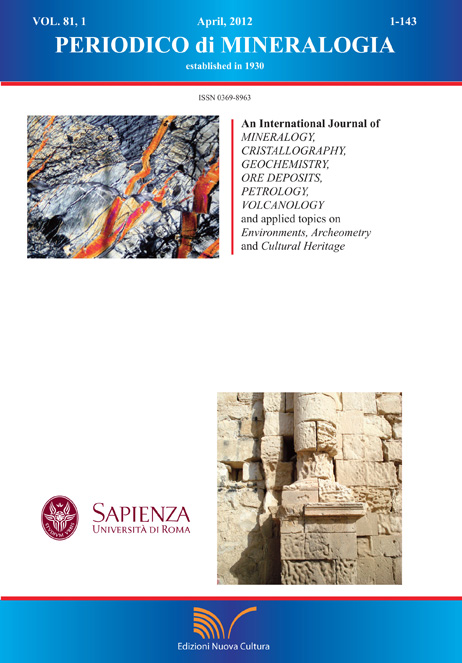Spinel-peridotites of the Frido Unit ophiolites (Southern Apennine-Italy): evidence for oceanic evolution
DOI:
https://doi.org/10.2451/2012PM0003Keywords:
Southern Apennine, Frido Unit, ocean-floor metamorphism, ophiolites, serpentinites, spinel.Abstract
The ophiolitic rocks of the Frido Unit include serpentinites derived from a lherzolitic to cpx-rich harzburgitic mantle, as suggested by microstructural and petrographical features. The serpentinites are englobed in tectonic slices where they are associated with mafic dykes and medium to high-grade metamorphic rocks such as amphibolites, gneiss, granofels as well as gabbros and basalts with pillow structures. The matrix of tectonic slices is mainly composed of calchschists and phyllites. The serpentinites of the Frido Unit show pseudomorphic and vein textures. Primary mantle minerals are represented by olivine, orthopyroxene, clinopyroxene and spinel and are identifiable either for the occurrence of mineral relics or pseudomorphs maintaining the mineral shape. Pseudomorphic minerals are serpentine, magnetite, chlorite, and tremolite. Olivine is replaced by serpentine forming a mesh texture; orthopyroxene is mostly altered to bastite; in some cases it shows exsolution lamellae of clinopyroxene and kink bands; fresh orthopyroxene is preserved as exsolution inside clinopyroxene porphyroclasts. Clinopyroxene is armoured by tremolite rim. Spinel shows a holly-leaf habit and is often armoured by a corona of Cr-chlorite. The core of the analyzed spinel has a Cr-Al spinel composition corresponding to chromite (Al2O3=29-31 wt %; Cr2O3= 28-37 wt%), whereas the rim has a Fe-Cr spinel composition corresponding to ferrit-chromite (Al2O3= 1-2% wt; Cr2O3=28-30 wt %). The Cr-Al spinel/ferritchromite ratio may be various in different spinel porphyroclasts. Magnetite replaces spinel or occurs within the mesh textured serpentine. The metamorphic assemblages in the Frido Unit serpentinites allow to infer qualitatively the physical conditions operating during serpentinization. The metamorphic mineral assemblages are typical of the greenschist-amphibolite transition and greenschist facies conditions, as suggested by the occurrence of tremolite replacing clinopyroxene and of Cr-chlorite and ferrit-chromite after Al-rich chromite. These minerals were produced by interactions between hydrothermal fluids and mantle peridotites. Serpentinites are cut by veins filled with mineralogical assemblages typical of the prehnite-pumpellyite facies likely related to later orogenic Apennine evolution. HP/LT metamorphic conditions (blueschist facies) have been documented in mafic dykes enclosed in serpentinites, but similar conditions are not recorded in serpentinites. This suggests that P-T conditions during the orogenic event were not able to produce a HP/LT mineral assemblage in serpentinites.


